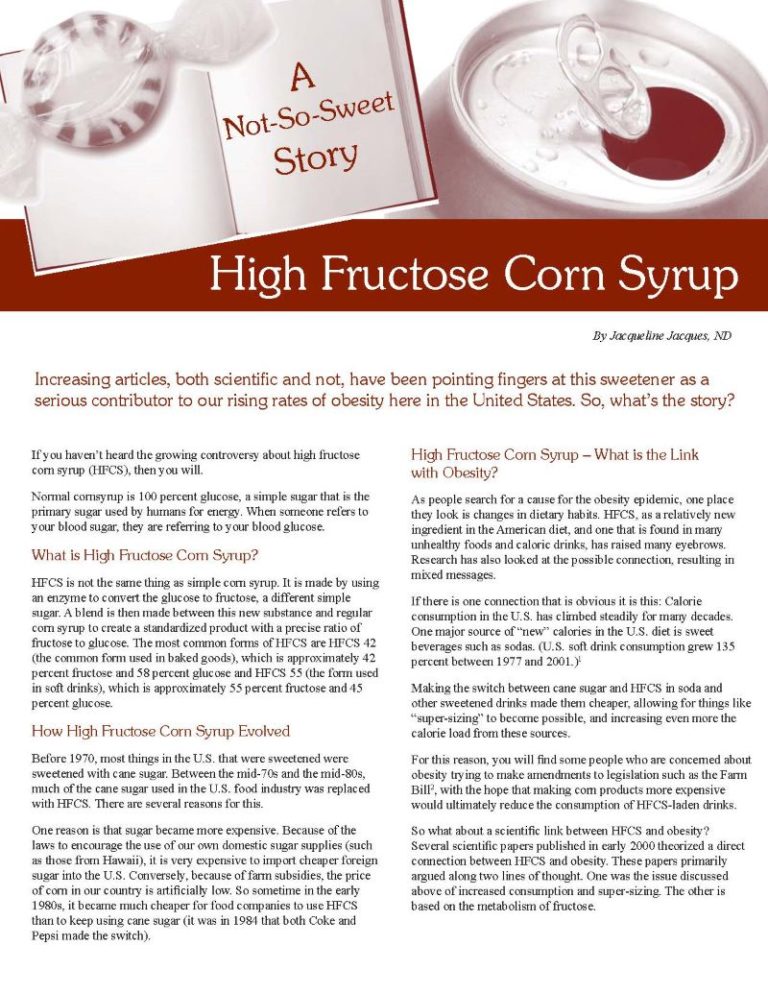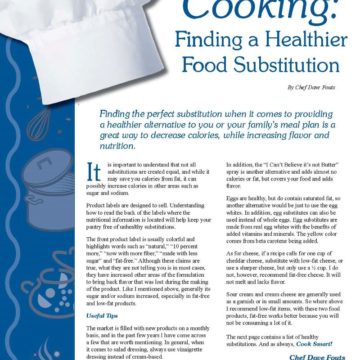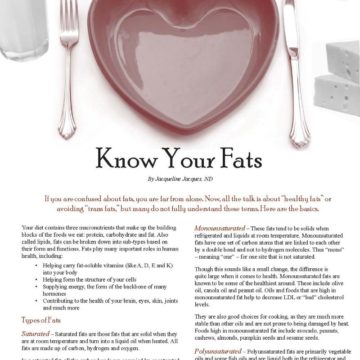A Not-So-Sweet Story – High Fructose Corn Syrup


by Jacqueline Jacques, ND
Winter 2008
Increasing articles, both scientific and not, have been pointing fingers at this sweetener as a serious contributor to our rising rates of obesity here in the United States. So, what’s the story?
If you haven’t heard the growing controversy about high fructose corn syrup (HFCS), you will. Normal corn syrup is 100 percent glucose, a simple sugar that is the primary sugar used by humans for energy. When someone refers blood sugar, they are referring to blood glucose.
What is High Fructose Corn Syrup?
HFCS is not the same thing as simple corn syrup. It is made by using an enzyme to convert the glucose to fructose, a different simple sugar. A blend is then made between this new substance and regular corn syrup to create a standardized product with a precise ratio of fructose to glucose. The most common forms of HFCS are HFCS 42 (the common form used in baked goods), which is approximately 42 percent fructose and 58 percent glucose and HFCS 55 (the form used in soft drinks), which is approximately 55 percent fructose and 45 percent glucose.
How High Fructose Corn Syrup Evolved
Before 1970, most things in the U.S. that were sweetened were sweetened with cane sugar. Between the mid-70s and the mid-80s, much of the cane sugar used in the U.S. food industry was replaced with HFCS. There are several reasons for this.
One reason is expenses. Because of the laws to encourage the use of our own domestic sugar supplies (such as those from Hawaii), it is very expensive to import cheaper foreign sugar into the U.S. Conversely, because of farm subsidies, the price of corn in our country is artificially low. So sometime in the early 1980s, it became much cheaper for food companies to use HFCS than to keep using cane sugar (it was in 1984 that both Coke and Pepsi made the switch).
High Fructose Corn Syrup – What is the Link with Obesity?
As people search for a cause for the obesity epidemic, one place they look is changes in dietary habits. HFCS, as a relatively new ingredient in the American diet, and one that is found in many unhealthy foods and caloric drinks, has raised many eyebrows. Research has also looked at the possible connection, resulting in mixed messages.
If there is one connection that’s obvious, it’s this: Calorie consumption in the U.S. has climbed steadily for decades. One major source of “new” calories in the U.S. diet is sweet beverages such as sodas. (U.S. soft drink consumption grew 135 percent between 1977 and 2001.)1
Making the switch between cane sugar and HFCS in soda and other sweetened drinks made them cheaper, allowing for things like “super-sizing” to become possible, and increasing even more the calorie load from these sources.
For this reason, you will find some people who are concerned about obesity trying to make amendments to legislation such as the Farm Bill2, with the hope that making corn products more expensive would ultimately reduce the consumption of HFCS-laden drinks.
So what about a scientific link between HFCS and obesity? Several scientific papers published in early 2000 theorized a direct connection between HFCS and obesity. These papers primarily argued along two lines of thought. One was the issue discussed above of increased consumption and super-sizing. The other is based on the metabolism of fructose.
Fructose and its Role
Fructose is metabolized differently in the body than glucose is. Glucose is transported into the cells of the body by the hormone insulin, fructose is not3. Therefore, its ingestion does not stimulate insulin release. This, in turn, means that fructose ingestion does not lead to the insulin-induced rise in leptin. As an increase in insulin and leptin are associated with satiety4, some researchers theorized that perhaps ingesting fructose instead of glucose leads people to consume more calories because they do not get the right signals to feel full.
High fructose diets also have been shown to lead to a more direct formation and storage of fat5. Additionally, despite not having the same impact on insulin secretion as glucose, fructose ingestion is strongly tied to the development of insulin resistance6 and Type-II Diabetes. This appears to occur because ingestion of a high-fructose diet leads to more fat production, including increased production of circulation triglycerides (a kind of fat)7.
Is Soda the Main Culprit in Weight Gain?
As more studies examined soda than any other drink, there is more evidence for a link between obesity and soda. Regardless of what they are sweetened with, drinks of this kind provide no nutritional value and are primarily a source of empty calories.
As noted by Vasanti S Malik, Matthias B Schulze, and Frank B Hu in their article, “Intake of sugar-sweetened beverages and weight gain: a systematic review:” “In the U.S., on average, a 12 oz serving (12 oz = 1 can of soda =1 serving) of soda provides 150 calories and 40–50 grams of sugar in the form of high fructose corn syrup (45 percent glucose and 55 percent fructose), which is equivalent to 10 teaspoons of table sugar. If these calories are added to the typical U.S. diet without reducing intake from other sources, 1 soda per day could lead to a weight gain of 15 lb, or 6.75 kg in 1 year12.”
In other words, this many extra calories from anything is likely to cause you to gain weight.
How this All Compares
All of this sounds pretty bad for HFCS. But remember, most HFCS is only a little more than half fructose. While it accounts for a lot of calories in the human diet, on average 132 calories/day for each person over the age of two8, only 55 percent of those are fructose calories.
By comparison, normal unsweetened apple juice is about 64 percent fructose9. Studies comparing weight gain from HFCS products and other sweeteners do not really exist. A recent review conducted by the United States Center for Food, Nutrition and Agriculture Policy found that while overall calories from fructose in the U.S. diet have increased, the ratio of fructose to glucose in the U.S. diet has stayed constant since roughly the 1960s.
Additionally, there is no evidence that weight gain is more likely to occur from the ingestion of foods and drinks sweetened with HFCS as compared to drinks using other caloric sweeteners or naturally caloric drinks such as fruit juice.
What Does this All Mean?
So what do you need to know? Right now, the current evidence does not really indicate that HFCS is any more responsible for obesity than any other sources of sugar. It may be that some of the metabolic issues we have discussed will eventually be shown to be a serious contributor to obesity, but right now, we do not have enough data to say.
What we do know is that consuming sweet drinks, whatever the source, does appear to contribute to weight gain and obesity. A recent systematic review of 30 studies examining the link between sweet beverages and weight found significant evidence that excess calories from soda, fruit drinks, fruit juice and other drinks all had some association with body weight11.
Remember, many sweet drinks are not sold in 12 ounce servings, but in 16, 20 or larger sizes. Until more is known, the best advice for the weight-conscious is to try to minimize consumption of sweet, caloric drinks. If you do include caloric beverages in your diet, opting for nutrient-rich drinks like 100 percent juice or milk instead of sodas or juice-flavored drinks may be wise, as is limiting serving size.
About the Author: Jacqueline Jacques, ND, is a Naturopathic Doctor with more than a decade of expertise in medical nutrition. She is the Chief Science Officer for Catalina Lifesciences LLC, a company dedicated to providing the best of nutritional care to weight-loss surgery patients. Her greatest love is empowering patients to better their own health. Dr. Jacques is a member of the OAC National Board of Directors.
References:
1. Popkin, B. American Journal of Preventive Medicine, October 2004. News release, University of North Carolina at Chapel Hill.
2. H.R.2419: To provide for the continuation of agricultural programs through fiscal year 2012, and for other purposes. https://thomas.loc.gov/cgi-bin/bdquery/z?d110:H.R.2419: Accessed 7 Dec 2007.
3. Curry DL. Effects of mannose and fructose on the synthesis and secretion of insulin. Pancreas1989;4:2–9.
4. Schwartz MW, Woods SC, Porte D Jr, Seeley RJ, Baskin DG. Central nervous system control of food intake. Nature2000;404:661–71.
5. Hellerstein MK, Schwarz JM, Neese RA. Regulation of hepatic de novo lipogenesis in humans. Annu Rev Nutr 1996;16:523–57.
6. Elliott SS, Keim NL, Stern JS, Teff K, Havel PJ. Fructose, weight gain, and the insulin resistance syndrome. Am. J. Clinical Nutrition, Nov 2002; 76: 911 – 922.
7. Basciano H, Federico L, Adeli K. Fructose, insulin resistance, and metabolic dyslipidemia. Nutr Metab (Lond). 2005 Feb 21;2(1):5.
8. Bray, G. American Journal of Clinical Nutrition, April 2004; vol 79: pp 537-543.
9. Sheu MJ, Wiley RC. Influence of Reverse Osmosis on Sugar Retention in Apple Juice Concentration. Journal of Food Science, 1984; 49 (1), 304–305.
10. Forshee RA, Storey ML, Allison DB, Glinsmann WH, Hein GL, Lineback DR, Miller SA, Nicklas TA, Weaver GA, White JS. A critical examination of the evidence relating high fructose corn syrup and weight gain. Crit Rev Food Sci Nutr. 2007;47(6):561-82. Review.
11. Malik VS, Schulze MB, Hu FB. Intake of sugar-sweetened beverages and weight gain: a systematic review. Am J Clin Nutr. 2006 Aug;84(2):274-88. Review.
12. Ibid.
by Sarah Muntel, RD Spring 2024 Spring has sprung, bringing sunnier and warmer days! For many, this…
Read ArticleWith the holidays behind us and 2022 now here, many of us are ready to tackle our…
View Videoby Kristen Smith, MS, RDN Winter 2022 When you decide to change your dietary habits, it can…
Read Article









